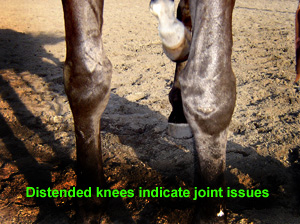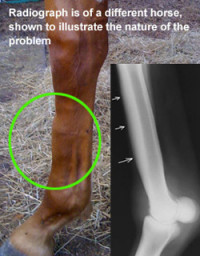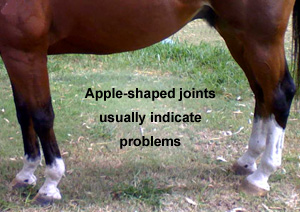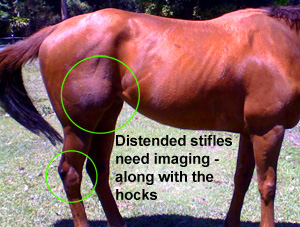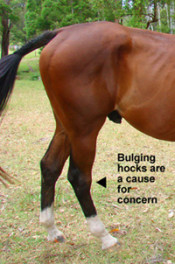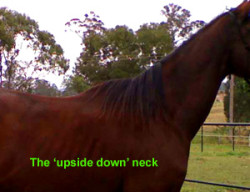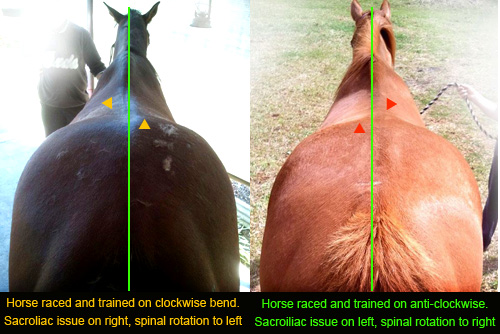In this guest post, Kerry Warren Couch responds to the article on this site about ex-racehorses by stating, clearly and simply, how she has helped her OTTBs over many years, mainly by initially doing very little at all.
(c) All text copyright of the author at www.thehorsesback.com. No reproduction of partial or entire text without permission. Sharing the link back to this page is fine. Please contact jane@thehorsesback.com for more information. Thank you!
Kerry writes:
Sometimes, you can achieve more by doing very little. There’s a lot advice around about what you can do to help ex-racehorses, or OTTBs (Off the Track Thoroughbreds). Much of it focuses on what can be done through retraining, while some of it focuses on dealing with physical issues.
I have ridden many OTTBs over the decades of my riding career, professionally and for sheer pleasure. I just adore them – they have so much heart, and they give everything if the rider is willing to be extraordinarily patient, partnering with their horse and never forcing them.
I loved the Buying an Ex-Racehorse: Can You Spot the Major Physical Issues? article – it’s absolutely on target. I have a few suggestions for folks to consider when they bring their OTTBs home. These come from my personal experience – they may not apply to everyone and all cases, so do keep that in mind.
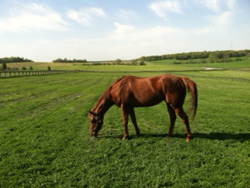
Seven months ago, I purchased yet another OTTB. He came from a top trainer/track and we knew his entire medical history, including x-rays. This is NOT typical – I was very fortunate to have access and for my vet to be able to talk with the stable and their vets. Very lucky me.
Despite coming from a top trainer, my new OTTB does have some issues – he IS an ex-race horse, so this is to be expected.
He has benefited from my usual approach, which helps the horse long before we start work.
What follows is my approach to helping every OTTB that comes to live at my farm.
1. Allow the OTTB plenty of downtime
My OTTBs have always needed time to ‘defuse’ from the training barn life, so I turn them out, slowly to acclimatize.
But then as they come to understand turn out, I find them pasture mates and allow turn-out at will, so they can go in their stalls or walk out to the field as they wish.
2. Give the OTTB a full check-up
I have a complete chiro assessment done before ANY work is begun – and that includes groundwork.
We start working on the serious physical issues right away, but leave simple ones for a little later, so we don’t overwhelm the horse in his transition to a non-track life.
3. Use paddock time as self-help time
I am lucky that my farm has hills, so I can help my OTTBs work on symmetrical muscle building long before I begin groundwork.
I purposefully keep their water in their stalls so they must walk the hills every day, from pasture to barn and back.
Their attitudes really change with this time to ‘reprogram’.
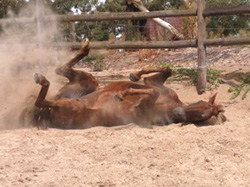 I also have a designated ‘rolling area’ near the paddock, filled with super soft sand. I have been amazed at how smaller, simpler issues can be naturally worked out by allowing horses to relax and roll in lovely sand.
I also have a designated ‘rolling area’ near the paddock, filled with super soft sand. I have been amazed at how smaller, simpler issues can be naturally worked out by allowing horses to relax and roll in lovely sand.
My region has hard clay soil, so I had the sand area made, because I know that rolling on hard clay can actually cause or exacerbate injuries. It’s not that expensive and I’ve found that horses LOVE it.
Do consider putting it in a well-drained area with a little bit of full sun, as warm sand is wonderful!
4. Use grooming as therapy time
I groom them every day – slowly and methodically. I fully believe this has wonderful therapeutic benefits.
It helps with circulation and muscle tone, and helps me partner with my horses without asking anything of them.
5. Work out an individual nutritional plan
Where feed’s concerned, I have full blood panels done and put a nutrition program together based on each horse’s needs. These vary from horse to horse.
I have been fortunate to acquire OTTBs from known training barns, so my horses typically have few deficiencies. This may NOT be the case for so many people who are purchasing OTTBs from a TB rescue operation or general sale.
By the way, I am NOT implying that rescue groups do not take care of the horses. It’s just that sometimes, the rescue folks aren’t told about the horse’s medical history, so they simply don’t know. It is not due to any lack of care or concern on their part.

We some times see minor anemia, and imbalance in the micro-minerals. Many OTTBs do have some signs and symptoms of gastric discomfort. This may reflect fore or hind gut ulcers.
I don’t like to have an endoscopy performed, as the pre and post procedures often exacerbate the ulcers, if they do exist.
I actually prefer to treat this area empirically. So, if my vet and I both feel the horse is exhibiting signs consistent with ulcers, we treat them without the instrumental diagnostics.
That said, if there IS a serious issue, one certainly may wish to pursue the endoscopy.
Diet is really individualized to the horse. It is not advisable to suddenly change a horse’s diet. I like to implement a tapering program. I keep the horse on whatever he was being fed at the training barn for two weeks, with a very slow changeover to whatever program we have determined for the new horse.
I typically have acquired very young OTTBs, ie, 3-4 year olds. So I know my horses are still growing and will require nutrition appropriate to a growing horse. We do feed a LOW carbohydrate feed mix and will supplement as warranted.
If one feeds the proper amount as recommended by the feed company and one’s vet, the horse ought to receive the right blend of vitamins and minerals.
I do like to add flax seed meal, not the seeds. If a horse has really thin walls or poor feet, I add a hoof supplement with biotin and trace minerals. If a horse requires, we will add probiotics.
If a horse is a poor drinker, I may add some soaked, drained, no-molasses-added beet pulp.
I think the main thing here is that no two horses are exactly the same. There is NO cookie cutter approach to caring for horses. There are only general principles:
- Fresh, clean water, daily (scrub out those water buckets).
- Plenty of quality hay and forage at will, so the horse does not stand for hours without roughage (the average 1100 lbs horse requires approx 22 lbs of total quality forage a day, which can be a combination of pasture and hay, all hay or all pasture).
- Get the horse out, moving at will in a pasture so the fore and hind gut can work effectively.
- Make sure a dentist has assessed their teeth.
- A fecal test is also a good idea, especially for OTTBs coming from a rescue or general sale. Good training barns have a worming routine. This may not be the case with a rescue operation or at a general sale when one doesn’t know much about the OTTB’s origin.
- I also know the vaccination history of my newly acquired horses, but this may not always be the case for others. I’d advise anyone to discuss this with the veterinarian.
6. Improve poor hoof balance slowly
I get the farrier in from the beginning to slowly – NOT rapidly – change those hoof angles over several months of trims.
Most OTTBs have under run heels, long toes and flat soles.
A slow correction allows longer term adaptation of the hoof structures and avoids short term soreness. It also avoids dramatic changes that affect posture
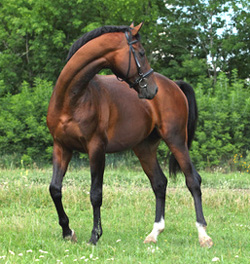 One MUST take it very slowly. I believe this holds true for any horse, but particularly for the OTTBs.
One MUST take it very slowly. I believe this holds true for any horse, but particularly for the OTTBs.
Their muscles, tendons and ligaments are put at risk if angle changes are made too rapidly. It leads to transitory lameness, soreness and increased risk of injury, even in the pasture.
I offer the analogy of a person wearing barn boots, day-in, day-out.
Then, suddenly switching to three inch high heels and attempting to carry out the same daily chores. OUCH!
I think it is SO important to have all the professionals involved in the horse’s care/transition on the same page and are informed of each other’s interventions with the horse.
It’s really important to have the big players on the ‘team’ communicating with one another: the chiropractor, the farrier, the vet/nutritionist, hay and feed dealer.
7. Allow time for slow and steady progress
I have also found that my OTTBs have really needed to learn how to enjoy other horses and life before I start any type of training program.
We humans seem to be in such a hurry. It’s so helpful to let their bodies and minds defuse.
I have noted that less experienced horse owners would do well to remember that these horses are NOT, at this stage, pets. They have frequently not been cuddled or hand fed carrots, or hugged or loved.
These horses were working horses. They had a job to do.
I have observed some people new to horses being so enthralled with the idea of adopting an OTTB that they immediately want to love them, pet them, stand very close to them and even throw their arms around their necks.
This is a lovely sentiment but oh, so dangerous. Ex-track horses are often more accustomed to varied stall muckers coming in, varied groomers, different hot walkers, exercise riders, jockeys, etc.
So many OTTBs are simply NOT accustomed to being fussed. They may pin their ears and toss their heads to even bite or nip at the new owner, raise a hind foot, or wring the tail as a warning.
People new to horses who start with an OTTB really really need to be aware of this and put together a realistic plan to allow the horse to defuse, detox, rebuild and SLOWLY re-acclimatize to a life where his new people will show affection.
This happens over weeks or months – NOT days. Take it very slowly and give the horse his personal space and time to come to you – don’t force your eager affection on the horse too soon. It may likely backfire.
In time, with patience and understanding, you WILL have a lovely, affectionate horse. But not right away, as a general rule.
Talking to your horses daily, or singing, is good – I sing a lot to my horses so that they learn my voice and intonations. I do this over a long period, way before I ever attempt to be affectionate with my new OTTB. And even then, I wait for my horse to show me he is ready for me to rub his ears, etc.
Grooming helps this along, too. I often sing while I groom.
8. Enjoy starting work with your OTTB
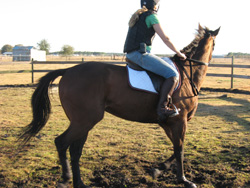
With all this, they are so much easier to work with – even for their rehab therapies, and physical therapy is always part of the program.
They ARE off the track and there WILL be issues, almost always hips, pelvis, back and others…
I give my OTTBs six full months, and sometimes up to a year, as each horse is different.
I know that may not be reasonable for many people, but even so, at least three months would yield a big benefit.
I do hope others have suggestions to add in the Comments section, below. Horses are such magnificent and amazing creatures. I have spent my lifetime, to date, with them, and I feel I have merely scratched the surface of understanding. I learn something new every single day. They are wonderful teachers, if we simply have the heart and open mind to ‘listen’ to their voices.
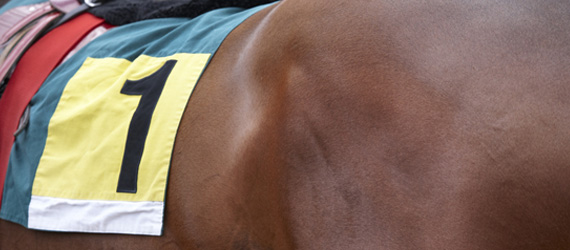
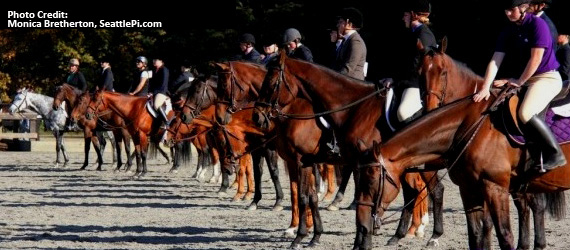

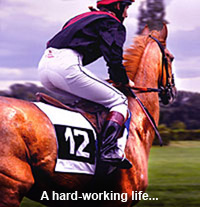
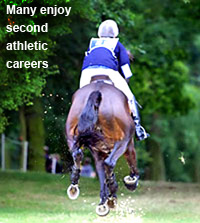
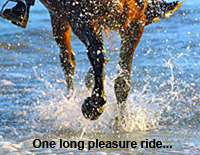
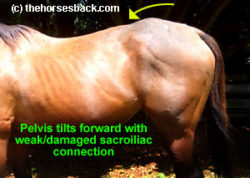
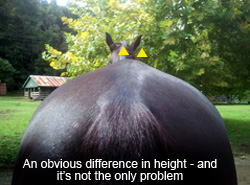
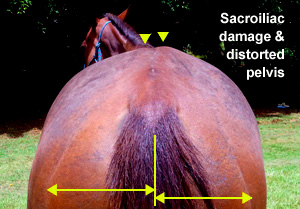
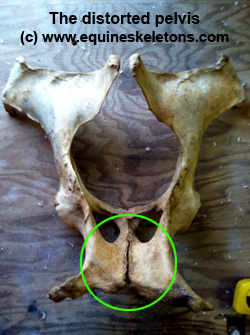
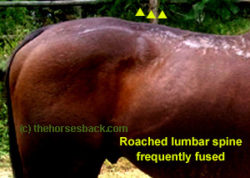
 A long-term rotated lumbar spine will usually have some fusion between the vertebrae, and/or overriding dorsal processes (the part of the vertebrae you can feel). Fused areas are painful for the horse while they’re happening, and OK once the fusion is complete. But if fusion cracks, it can once more be extremely painful. Many horses compete just fine with some fusion, but if it’s severe, there’ll be problems with flexion, both vertical and lateral.
A long-term rotated lumbar spine will usually have some fusion between the vertebrae, and/or overriding dorsal processes (the part of the vertebrae you can feel). Fused areas are painful for the horse while they’re happening, and OK once the fusion is complete. But if fusion cracks, it can once more be extremely painful. Many horses compete just fine with some fusion, but if it’s severe, there’ll be problems with flexion, both vertical and lateral.